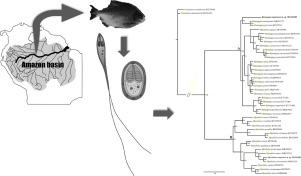当前位置:
X-MOL 学术
›
Acta Trop.
›
论文详情
Our official English website, www.x-mol.net, welcomes your feedback! (Note: you will need to create a separate account there.)
Morphology and molecular data of two novel cnidarian myxosporean (Myxobolidae) infecting Piaractus brachypomus from the Amazon basin.
Acta Tropica ( IF 2.7 ) Pub Date : 2020-05-19 , DOI: 10.1016/j.actatropica.2020.105533 Kassia R H Capodifoglio 1 , Caroline M Meira 1 , Marcia R M da Silva 1 , Lincoln L Corrêa 2 , Edson A Adriano 3 , Antonio A M Maia 1
Acta Tropica ( IF 2.7 ) Pub Date : 2020-05-19 , DOI: 10.1016/j.actatropica.2020.105533 Kassia R H Capodifoglio 1 , Caroline M Meira 1 , Marcia R M da Silva 1 , Lincoln L Corrêa 2 , Edson A Adriano 3 , Antonio A M Maia 1
Affiliation

|
The objective of this study was reports, through morphological and small subunit ribosomal DNA (SSU rDNA) sequencing, two novel myxobolid myxosporeans infecting Piaractus brachypomus, an economicaly important Amazonian fish popularly known as "pirapitinga". Of a total of 25 specimens of P. brachypomus examined 68% had the gill filament parasitized by Henneguya tapariensis n. sp. and 16% had infection of Myxobolus arapiuns n. sp. in the pyloric cecum. The morphological analysis revealed H. tapariensis n. sp. myxospores with an ellipsoid shape and caudal process larger than the length of the body. The polar capsules of same size were elongated and occupied less than half the body. Sequencing of the SSU rDNA generated a partial sequence of 1946 bp. In M. arapiuns n. sp. the myxospores had oval-shaped body and polar capsules of the same size, occupying less than half the body. Sequencing of the SSU rDNA generated a partial sequence of 1950 bp. Phylogenetic analysis revealed a cluster according to the order/family of the host, where H. tapariensis n. sp. was grouped in a subclade with Henneguya brachypomus and Henneguya piaractus and M. arapiuns grouped in a subclade with Myxobolus colossomatis, Myxobolus matosi and Myxobolus pirapitingae.
中文翻译:

两种新颖的刺胞肉食性粘虫孢子(Myxobolidae)感染亚马逊河流域的Piaractus brachypomus的形态和分子数据。
这项研究的目的是通过形态学和小的亚基核糖体DNA(SSU rDNA)测序,报道两种新颖的粘脂性粘孢子虫感染了Piaractus brachypomus,这是一种经济上重要的亚马逊鱼类,被普遍称为“ pirapitinga”。在总共检查的25个短螺旋体标本中,有68%的the丝被Henneguya tapariensis n寄生。sp。16%的人感染了粘胶粘菌。sp。在幽门盲肠。形态分析表明,H。tapariensis n.。sp。粘孢子具有椭圆形的形状,尾突大于身体的长度。相同大小的极地囊被拉长并占据不到一半的身体。SSU rDNA的测序产生了1946 bp的部分序列。在M. arapiuns中 sp。粘孢子具有椭圆形的身体和大小相同的极地荚膜,占不到身体的一半。SSU rDNA的测序产生了1950 bp的部分序列。系统发生分析揭示了根据宿主的顺序/家族的簇,其中H. tapariensis n。sp。将其与Henneguya brachypomus和Henneguya piaractus分组在一起,将M. arapiuns与Mixobolus colossomatis,Mixobolus matosi和Mixobolus pirapitingae分组在一起。
更新日期:2020-05-19
中文翻译:

两种新颖的刺胞肉食性粘虫孢子(Myxobolidae)感染亚马逊河流域的Piaractus brachypomus的形态和分子数据。
这项研究的目的是通过形态学和小的亚基核糖体DNA(SSU rDNA)测序,报道两种新颖的粘脂性粘孢子虫感染了Piaractus brachypomus,这是一种经济上重要的亚马逊鱼类,被普遍称为“ pirapitinga”。在总共检查的25个短螺旋体标本中,有68%的the丝被Henneguya tapariensis n寄生。sp。16%的人感染了粘胶粘菌。sp。在幽门盲肠。形态分析表明,H。tapariensis n.。sp。粘孢子具有椭圆形的形状,尾突大于身体的长度。相同大小的极地囊被拉长并占据不到一半的身体。SSU rDNA的测序产生了1946 bp的部分序列。在M. arapiuns中 sp。粘孢子具有椭圆形的身体和大小相同的极地荚膜,占不到身体的一半。SSU rDNA的测序产生了1950 bp的部分序列。系统发生分析揭示了根据宿主的顺序/家族的簇,其中H. tapariensis n。sp。将其与Henneguya brachypomus和Henneguya piaractus分组在一起,将M. arapiuns与Mixobolus colossomatis,Mixobolus matosi和Mixobolus pirapitingae分组在一起。



























 京公网安备 11010802027423号
京公网安备 11010802027423号